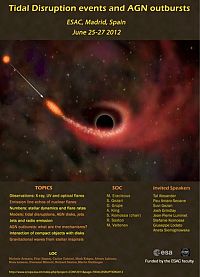›Tidal Disruption events and AGN outbursts
Gigantic X-ray, UV and optical flares have been seen from the nuclei of a small number of galaxies. These extraordinary flares have been interpreted as the tidal disruption of a stellar object by a quiescent black hole, if the hosts were non-active, or as dramatic changes in the accretion environment, if the galaxy appeared as a classical AGN.
The very distinctive lightcurves and spectra of tidal disruption events (TDE), predicted in advance by pioneering theoretical work, clearly distinguish them from AGN activity and establish them as an important field of study in their own right.
Recent, high-quality observations of TDE, differ in detail from early expectations of thermal emission from steadily returning stellar debris and challenge the sophisticated theoretical and numerical models which are now emerging.
Large, and very rare, flux changes in known AGN, pose challenges for our understanding of accretion disk processes and the immediate nuclear environment.
The discovery of jetted emission from SWIFT J1644+57, probably induced by a stellar disruption, has opened a new window into the phenomenon and provides a further link between tidal disruption events and AGN.
Over the next few years, sensitive, large-area, surveys will come on-line and likely detect extragalactic flares in large numbers. This workshop is designed to bring together theorists and observers for a review of previous observations and state-of-the-art modelling, and help to develop a strategy for the identification and follow-up of future events.
The workshop aims to address the following topics:
- Observations: what giant flares have been seen to date in the X-ray, UV and optical?
- Numbers: what are the stellar dynamics in galaxy cores, what is the rate of flares and are they important for the universal fueling of (super)massive black holes?
- New missions/surveys: what is coming; how many objects will they find; what will they be able to measure and to what accuracy - eRosita, PanStarrs, LSST, LAMOST, LOFAR....
- Theoretical explanations: Tidal disruptions, AGN disks, jets - what do they predict and what needs to be observed to test the models ?
- Tidal disruption models: how does tidal disruption, tidal detonation and tidal stripping work? How much gas is accreted, how much expelled? Do strong disk winds develop, and when?
- Jets and radio emission: when and how are jets formed during a disruption? What is their evolution?
- Emission line light echoes from a nuclear flare: what can they tell us about the circumnuclear material?
- AGN outbursts: what are the mechanisms and are some of them related to tidal disruptions?
- Interaction of stellar or compact objects with an accretion disk: how to search for periodic flare patterns and characteristic thermal bremsstrahlung spectra?
- What are the sources of false alarms: changes in line-of-sight obscuration to AGN, SNe, ULX, BLAZARS, GRBs and how can we discriminate against them (or are they physically related)?
- Gravitational waves: what can be detected from stellar inspirals, partial disruption of compact stars and binary black hole mergers?
- Applications: how can we use tidal flares to detect massive binary black holes and recoiling black holes ? What do they tell us about stellar dynamics in galactic nuclei? What else can we use them for?
How to plan a follow-up campaign: what needs to be observed and when?
Track this event on your Apple calendar














 Spain
Spain